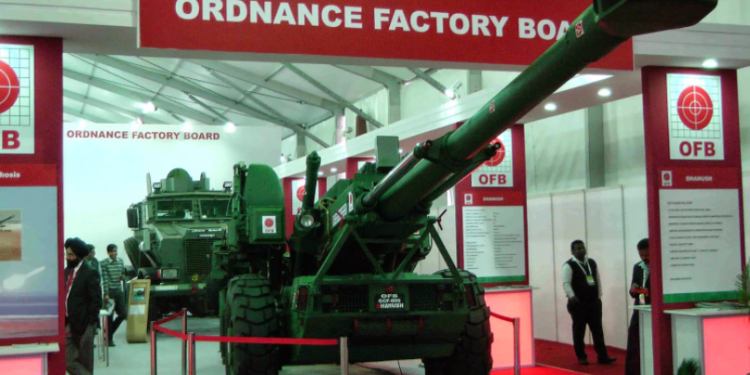Indian Army, in its internal assessment, has found that poor quality defence equipment supplied by Ordnance Factories Board (OFB), has led to 27 deaths and loss of 960 crore rupees to the government since 2014. OFB, a government-owned production unit, is known for its inefficiency and ‘Communist’ work culture. Its inefficient equipment has led to the loss of soldiers as well as money to Indian armed forces.
Headquartered in Kolkata, OFB is said to be among the oldest and most inefficient organizations in the world. A white elephant of the Nehruvian economy, it employs more than 80,000 people in 41 ordnance factories, 13 ordnance R&D centres, and nine ordnance institutes of learning. A few months ago the government decided to corporatize the OFB to make the institution more efficient, but, the employees of Ordnance Factories have called for an indefinite strike from October 12 against the decision.
In its internal assessment, the Armed forces found that the neighbouring countries refused to buy defence equipment from the Ordnance factory even when they are offered line of credit (LoC) to purchase them. However, defending itself, the Ordnance Factory Board, which is under the Department of Defence Production, said that only 2 per cent of the casualties are due to faulty equipment.
“The defect investigation is carried out by a committee headed by the Authority Holding Sealed Particulars (AHSP) which is the custodian of the manufacturing documents,” it said. “The committees include representatives of all the stakeholders including the user. The investigations carried out by these committees are seldom holistic, despite the fact that OFB has been insisting on such an approach,” it added.
But, crafty statements could not hide the failures of OFB, which has proved to be a burden on Indian Armed forces throughout its existence. Due to the ownership by the state, socialist work culture is prevalent in the organization, and its inefficiencies are worrysome.
Often called the “fourth arm of defence”, it is disliked by the rest of the three arms- Army, Navy, and Air Force- due to production of inefficient weapons and untimely delivery. The Armed forces are often forced to procure some low-skilled arms and ammunition from Ordnance factories because it has no other buyer, given inefficient and sub-standard products. In May 2019, The Tribune reported, “The Army has sought immediate intervention of the Defence Ministry to check rising cases of accidents involving battle tanks, artillery and air defence guns due to ‘poor quality’ of ammunition being supplied by the OFB.”
The Department of Defense Production, under which state-owned production units like HAL, Ordnance Factories, and many other companies operate, remains the weakest link of the Indian armed forces. The country had to spend billions of dollars on defence procurement due to inefficiency of OFB, HAL and other state-owned producers. Despite their decades of existence and India’s third-largest defence budget, OFB and HAL- two of the largest state-owned contractors of Indian armed forces- ranks 37th and 38th in the global ranking of the defence contractors by revenue.
The allies of India like Sri Lanka, Bangladesh, Maldives, and Myanmar are forced to purchase defence equipment from enemy countries like China due to inefficiency of India’s state-owned producers. These countries are defence allies of India, but, they purchase defence equipment from China because Indian companies are not able to meet their demand, and how would they? These companies cannot meet the demand of Indian armed forces and if our domestic forces are not willing to use equipment manufactured by OFB and HAL, why would any foreign country go for them.
Apart from the purchase of the rotten equipment worth around 14,000 crore rupees, the Ministry of Defence also gives around 700 crore rupees to the Ordnance Factory Board to subsidize their losses from the overall operation. Similarly, HAL continues to have a red balance sheet despite the purchase of its inefficient equipment by the armed forces. Successive CAG reports have criticized the OFB for its inefficiencies.
As per the report, Ordnance factories achieved production targets only for 49 per cent of items and expenditure on human resources constituted 33 per cent of budget compared to 20 per cent on average for private companies. And, the audacity of the OFB employees is such that they are ready to protest despite bagging 33 per cent of expenditure and making OFB bankrupt while supplying sub-standard products to Armed forces.
“Work-in-progress (unfinished items lying on the shop floor) constituted 32 per cent of the inventory. Orders as old as the year 2009-10 were yet to be delivered, a delay of 10 years. Apple graduated from iphone 4 to iphone 11 within this period and here we are still in a primitive state of functioning.” wrote Rajan Kochhar, retired Major General, in Economic Times, on Ordnance Factories.
As per the CAG report, the inefficiency of Ordnance Factories adversely affects the preparedness of Indian Armed Forces at a time when the country faces the threat of a two-front war. “A significant quantity of the Army’s demand for some principal ammunition items remained outstanding as on 31 March 2018, thus adversely affecting their operational preparedness. In addition, the exports by OFB decreased by 39 per cent in 2017-18 over 2016-17,” the CAG report said.
Given the Himalayan inefficiencies of Ordnance Factory Board, the government must pull up employees who are protesting against the corporatization of the organization. For the sake of our armed forces that are facing China on one front and Pakistan on the other, OFB, the white elephant of the Nehruvian economy should be corporatized as soon as possible.































